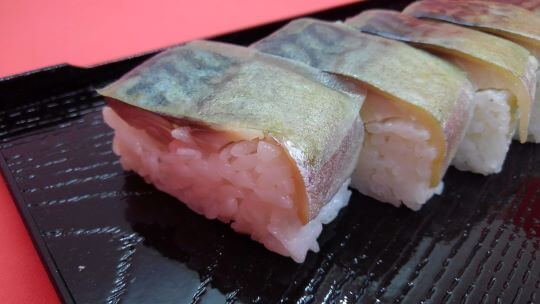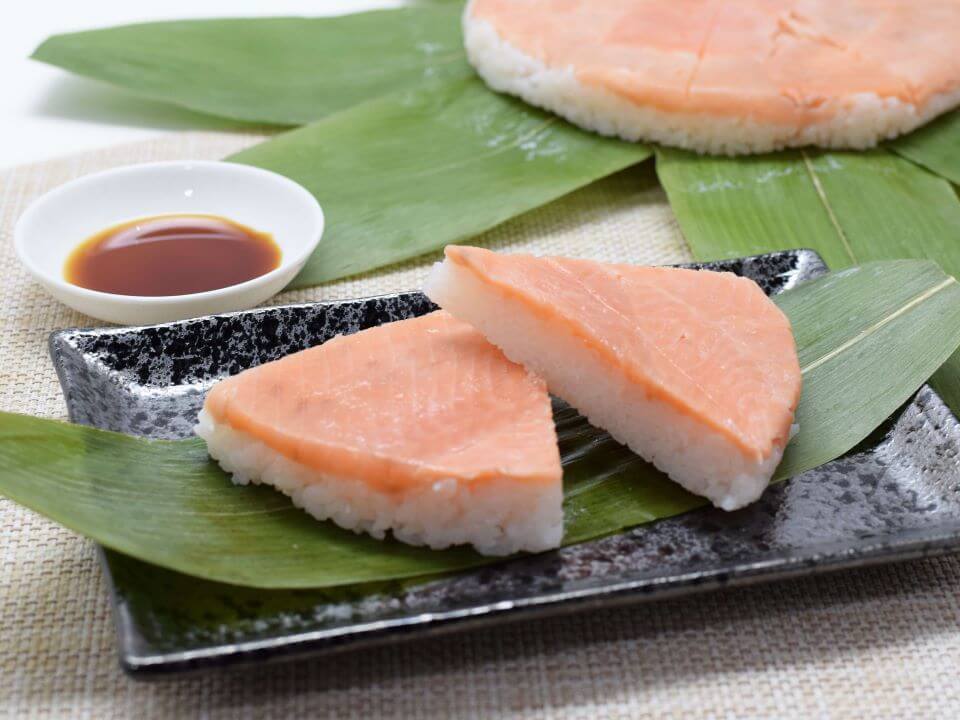 While not often seen in Tokyo, “Whole mackerel sushi” is popular in Kyoto and Osaka. This is pressed sushi made by placing vinegared saba (mackerel) on top of sushi rice and shiroita-kombu (kelp that has been lightly shaved down) on top of that, and is normally called “battera” in Kansai.
While not often seen in Tokyo, “Whole mackerel sushi” is popular in Kyoto and Osaka. This is pressed sushi made by placing vinegared saba (mackerel) on top of sushi rice and shiroita-kombu (kelp that has been lightly shaved down) on top of that, and is normally called “battera” in Kansai.
It would make sense to call it saba pressed sushi, but a customer actually came up with this weird name, “battera”.
Around 1890, there was an exceptionally large number of konoshiro (gizzard shad) fish for the year. A sushi restaurant took notice of the cheap konoshiro, butterflied it, made it into fukin-jime, then sold it in this shape that resembled a boat. Apparently it used to look more like a boat than the present-day battera.
As the Portuguese word for “boat” is “batela”, someone started ordering by saying things like, “Give me a couple of battera.” Eventually battera became the official name.
Before long, konoshiro hauls dropped and so it was replaced with saba. Also, in order to preserve moisture, sushi chefs started to wrap it in kelp sent by ship from Hokkaido. The shape now is a long, skinny rectangle and it no longer resembles a boat, but the name remains.
[sc_apply url=”https://sushiuniversity.jp/apply/”]
We hope this information will be helpful.

Revision date: August 12, 2021
Share this article
 The origin of Masuzushi dates back about 300 years. Apparently, in 1717 it was first presented as Ayu narezushi (narezushi is a traditional food, said to be the original form of sushi and made from lactic fermentation of fish) to the third-generation feudal lord, Toshioki Maeda, by Shinpachi Yoshimura, a feudal retainer of Toyama who excelled in cooking skills. Toshioki liked the dish very much and assigned the role of vinegaring Ayu to Shinpachi. After that, it is said that the same narezushi was presented to the eighth shogun of the Tokugawa shogunate, Yoshimune Tokugawa, and that Yoshimune was extremely pleased with it.
The origin of Masuzushi dates back about 300 years. Apparently, in 1717 it was first presented as Ayu narezushi (narezushi is a traditional food, said to be the original form of sushi and made from lactic fermentation of fish) to the third-generation feudal lord, Toshioki Maeda, by Shinpachi Yoshimura, a feudal retainer of Toyama who excelled in cooking skills. Toshioki liked the dish very much and assigned the role of vinegaring Ayu to Shinpachi. After that, it is said that the same narezushi was presented to the eighth shogun of the Tokugawa shogunate, Yoshimune Tokugawa, and that Yoshimune was extremely pleased with it.